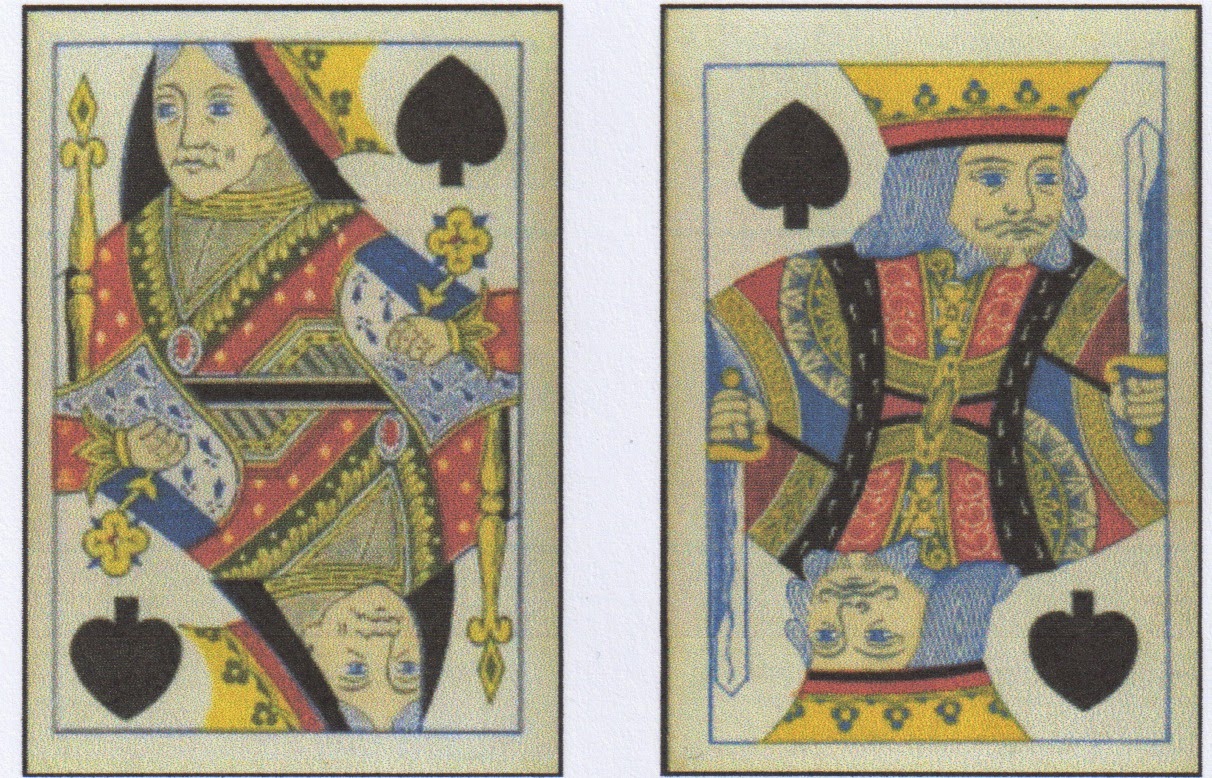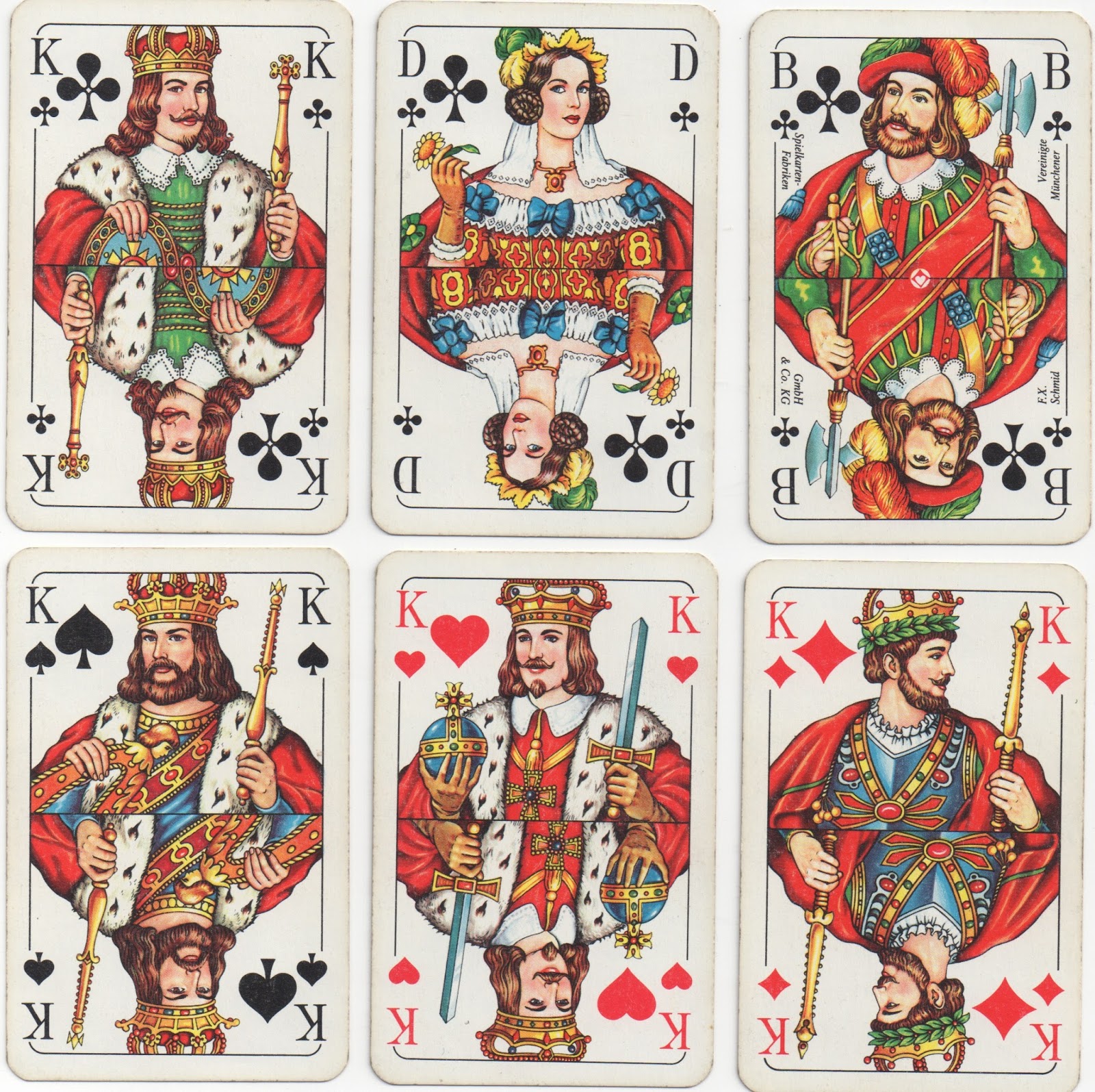38: HOW TO ANALYZE AND DIFFERENTIATE PLAYING CARD PLATES (DE LA RUE) [NEW 12.5.14]
THIS PAGE IS NOW TO BE FOUND AT: http://www.wopc.co.uk/blogs/kenlodge/analyzing-playing-card-plates
THERE ARE SOME ADDITIONS TO IT.
The book that Paul Bostock and I have recently published deals in detail with the analysis of wood-block courts (see Home Page for details). So, I thought it might be helpful to explain my approach to cards printed by the later methods from metal plates or lithographic stones. The same approach can be applied to modern computer-based printing, where there is variation, as in Chinese versions of the English pattern. Some firms, on the other hand, such as Carta Mundi and Fournier, have such consistent print runs that no variation can be detected. That makes these designs much less interesting to me.
THERE ARE SOME ADDITIONS TO IT.
The book that Paul Bostock and I have recently published deals in detail with the analysis of wood-block courts (see Home Page for details). So, I thought it might be helpful to explain my approach to cards printed by the later methods from metal plates or lithographic stones. The same approach can be applied to modern computer-based printing, where there is variation, as in Chinese versions of the English pattern. Some firms, on the other hand, such as Carta Mundi and Fournier, have such consistent print runs that no variation can be detected. That makes these designs much less interesting to me.
How
to analyze and differentiate plates.
As I said on page 40, my interest in stamp
variants led me to apply the same principles to playing cards. This is essentially the basis of my book The standard English pattern. The plates used by a maker may, in fact, be
unrelated, as in the case of De La Rue’s first designs and their third one. Although the basic arrangement of the figure
and his clothing is the same, so he is recognizable as belonging to the
standard English pattern, the details of the plates, especially of the clothing
are all very different. His attribute
varies, too. D1 is idiosyncratic,
anyway, and was part of an unpopular set of changes to the design; D2 follows the style of wood-block
production, in particular that of Type III, the version used mainly by
Reynolds in the 1830s, and D3 is a decorative version with the traditional components of the
clothing being retained, but with more intricate details. The bottom of his tunic has a zigzag edge,
there is an extra roundel on his sleeve at the left instead of a separate,
plain coloured section, and small decorative spades on his back and sleeves,
though they tend to loose their shape in the printing process.
D1 D2 D3
D4 D4.1 D5
In D4.1 there is extra overlaid design on
his chest, his hat has decoration on it (features found in D3) and the tunic panels are coloured
differently. D5 has been redrawn, most noticeable on the head and hands, with dots added to the right-hand roundel and an extra black stripe on his waist-band; the kings and queens have different designs
on their crowns, too.
D4.1
D5
After the turning process the outline
design of D6 was fixed for many years and used with different formats,
including different colour schemes and indices. The particular clue to this long-term use
can be found on the JC. There are two
breaks in his cuff at one end (probably damage), which is a constant feature of
all turned packs using a version of D6 from c.1875-1910.
D6
Turned JC detail
D6 D6.1, three colours
D6, but not D6.1, is found with the original Dexter indices with some variation, and the smallest corner indices with 1 for ace.
Dexter indices c.1878-90
The smallest indices with 1 for ace, c.1880-95
D6.1 is the same outline plate printed in
black instead of blue with just red and yellow added. There is a lot more superimposed decoration
on the clothing, too.
D6.1, small indices, c.1895 Larger indices, c.1910
The later packs, both wide and
bridge-width, have redrawings and the final version has a lot of changed
decoration on the clothing.
From top left: D6, D6.1, D7, D8, D9 wide, D9 bridge.
In the case of the two widths of D9 the same plates were used, whereas the wide D7 is different from the bridge-size D8. The approximate dates for the variants above from top left are: D6, 1890-1905; D6.1, 1890-1905; D7, 1905-20; D8, 1910-20; D9, 1922-28.
See also page 5 for other details of De La Rue.
I should explain here how I arrive at my alphanumeric designations. Each different first digit refers to the outline plates: if a new one is produced, it receives a new number, e.g. D1, D2, D3, above. The sequence has no particular significance, though they are usually in chronological order. (This may not be the case if two sets of courts co-occur, or if I have discovered a variant after having fixed the basic classification.) The decimal point system is used to differentiate variation using the same outline plate, so D4.1 has the same outline plates as D4, but the colour plates vary; similarly with D6 and D6.1. Copies of a design are prefixed with either X, if no originator of the copy is obvious, or a more local one, such as US for American copies and T for Turnhout copies, by whichever maker.
It is then possible to take this classification as a basis and see whether other makers took it as a model. So, for example, we find Brepols using D9 as a model right into the 1950s, long after De La Rue had ceased to print it.
Brepols copy of D9 (TD9)
Similarly, Van Genechten used De La Rue designs as models, both D3 and D4.1.
Van Genechten TD3
Van Genechten TD4.1
This particular maker was quite prolific in his use of other people's designs, but also adapted them further in his own versions. He redrew D3 with more of his own features and he even produced his own double-ended version.
Van Genechten TD3
Van Genechten TD3.1
Of course, this approach can be applied to any type of card, standard or non-standard, or card game. So, to finish off, here are some Berlin pattern variants.
VEB Altenburger Spielkarten, c.1950
F X Schmid, c.1980
Pelikan (makers of ink), ?c.2000
These are all different drawings of the pattern: look at the KS, for example, and note the differences in the edges of his cloak and the band across his chest.
After that we might want to ask whether the courts illustrated below are a mixed up version of the Berlin pattern or just a non-standard derived from it.
Nürnberger, c.1990
It's all in a day's collecting!





















0 Comments:
Post a Comment
Subscribe to Post Comments [Atom]
<< Home